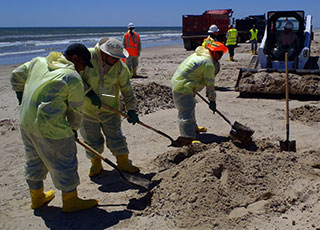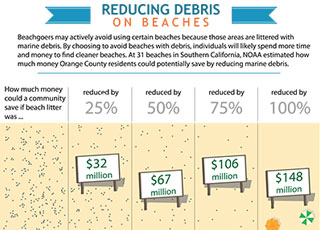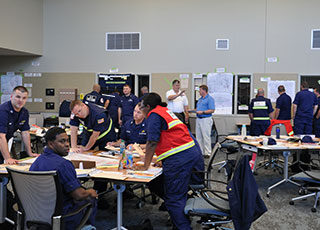
NOAA’s Office of Response and Restoration (OR&R) responded to the March 2014 collision of the bulk carrier M/V Summer Wind with the oil-tank barge Kirby 27706 in Galveston Bay at a dangerous intersection called the Texas City “Y,” where three lanes of vessel traffic converge: from the Port of Texas City, the Houston Ship Channel, and the Gulf Intracoastal Waterway. The collision closed the Houston Ship Channel for several days and resulted in the largest U.S. oil spill response since the 2010 Deepwater Horizon incident.
A substantial portion of the approximately 168,000 gallons of spilled fuel oil drifted 200 miles south and stranded on the beaches of Aransas National Wildlife Refuge, home to the endangered whooping crane. In addition to providing scientific support, such as modeling oil trajectories and identifying resources at risk, OR&R conducted aerial and shoreline surveys of the beaches to determine the degree of oiling, affected habitats, and cleanup recommendations. OR&R also worked extensively with NOAA’s National Weather Service, which provided spot weather forecasts, and NOAA’s National Marine Fisheries Service, which provided wildlife surveys and rehabilitation for marine mammals and sea turtles.
NOAA and other natural resource trustees are now in the process of conducting a Natural Resource Damage Assessment to identify injuries to natural resources, impacts to people’s use of resources, and restoration needs resulting from the spill.

Southern California residents lose millions of dollars every year avoiding littered local beaches in favor of cleaner beaches that are farther away and may cost more to reach, according to an economics study released in FY 14 and funded by the NOAA Marine Debris Program. The study, led by Industrial Economics, Inc., is the first of its kind to consider how marine debris influences people’s decisions to visit the beach, and what it may cost. The study found that reducing marine debris on beaches can prevent financial loss and provide economic benefits to residents. For beaches in and around Orange County, for example, reducing marine debris by even 25 percent could benefit residents by roughly $32 million during the summer months.

In FY 14, the airplane manufacturer Boeing Company completed a large habitat restoration project just south of Seattle on the Lower Duwamish River. Boeing worked with NOAA and partners under a Natural Resource Damage Assessment to restore habitat for fish, shorebirds, and wildlife harmed by historical hazardous substance releases on the heavily used urban river. Restoration included reshaping the shoreline, planting 170,000 native plants, and adding large woody debris to provide areas where young salmon can seek refuge from predators in the river. Two acres of wetlands were also constructed on the site, which Boeing will maintain to ensure productive habitat for years to come.

NOAA’s Gulf of Mexico Disaster Response Center sponsored or hosted 21 meetings, workshops, and training events in FY 14. These included a federal Regional Response Team meeting, a Homeland Security Exercise and Evaluation Program class, a tropical storm preparedness exercise co-sponsored by the National Weather Service, and NOAA’s Science of Oil Spills class. The center also hosted a class called Managing Floodplain Development (by the National Flood Insurance Program) for the Alabama Emergency Management Agency. In addition, the center provided meeting space for the Mobile County (AL) Emergency Management Agency for its annual Mass Care meeting. The center’s growing reputation as a central hub for all-hazards coordination fosters partnerships with NOAA and improves emergency preparedness throughout the Gulf region.
NOAA’s Office of Response and Restoration (OR&R) has a long history of developing tools for first responders to chemical releases. First responders worldwide use ALOHA (Areal Locations of Hazardous Atmospheres), a model developed jointly by OR&R and the U.S. Environmental Protection Agency’s Office of Emergency Management, to quickly determine the potential size of a toxic plume from a hazardous materials accident. In FY 14, scientists from OR&R and NOAA's Air Resources Laboratory (ARL) successfully combined features from ALOHA with HYSPLIT (Hybrid Single-Particle Lagrangian Integrated Trajectory), one of ARL’s primary models for plume prediction. The project combines the best capabilities of both models to provide a more robust forecasting tool for hazardous chemical incidents. The resulting tool (HYSPLIT with inclusion of ALOHA chemical source term algorithms) is now available to National Weather Service Weather Forecast Offices nationwide.
 An official website of the United States government.
Here's how you know we're official.
An official website of the United States government.
Here's how you know we're official.



